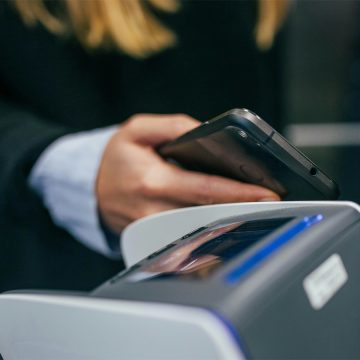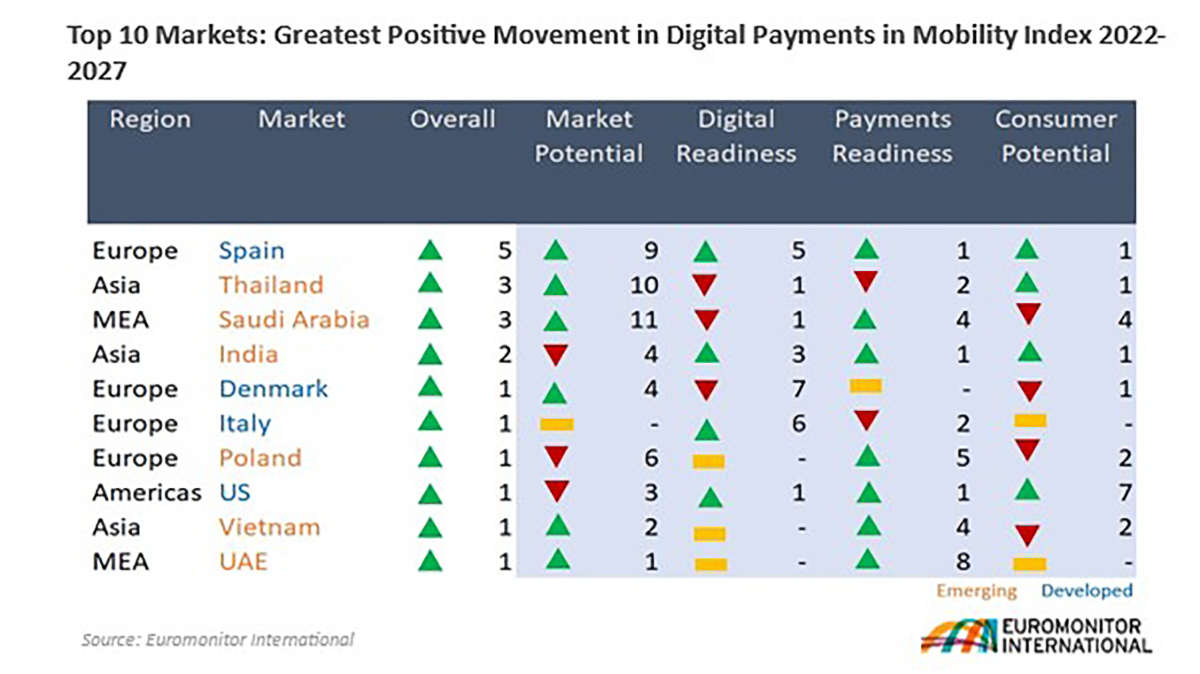FEATURED ARTICLE
Euromonitor International’s Digital Payments in Mobility Index, 2023
Related
Documents
Emerging markets are leading the way in digital payments for mobility due to increased market potential and payments readiness.
APAC and MEA will represent 60% of the global mobility e-commerce market by 2027 which emphasises the importance of financial and digital inclusion.
Open payment systems, MaaS platforms, and flexible payment options will be key for success in the mobility landscape, driven by advancements in technology and shifts in consumer preferences.
FEATURED ARTICLE
Consumer preference for seamless payments in most daily activities has also increased the adoption of digital payment solutions for mobility. As consumers expect an integrated, convenient, and secure payment solution, this has opened up the mobility sector as an avenue of payment innovation and partnership among payment specialists and mobility service providers across public and private sectors.

To help market players identify opportunities for digital payments within the mobility sector, Euromonitor International developed a Digital Payments in Mobility Index. The Index seeks to provide historic, current, and future rankings of 29 countries based on their attractiveness as mobility markets across four pillars: Market Potential; Digital Readiness; Payments Readiness; and Consumer Potential.
Based on the findings, forecast performances of countries show that the majority of improvements are expected to be from emerging markets, due to increased Market Potential and Payments Readines.1
Spain and Thailand will make the most strides in the index over the forecast period. Saudi Arabia will not only improve in Payments Readiness, given initiatives by Saudi Monetary Authority, along with Digital Readiness, but mobility e-commerce penetration in the overall transport sector is also expected to rise. The country will make the biggest stride in increased Market Potential globally. Saudi Arabia is also set to be among the top three markets making the most strides in Payments Readiness.

Asia Pacific and Middle East and Africa are expected to collectively account for 60% of the global mobility e-commerce market in 2027. While a large part of this growth comes from sizeable consumer potential and developing e-commerce solutions for mobility, financial and digital inclusion will remain a key area of development to convert mobility e-commerce transactions into digital payments.

The rise of mobility e-commerce has reduced cash and traditional ticket use in urban transit. From enhancing user experience through efficient and seamless payments to bringing cost efficiencies to mass transit systems, payments have played a dual role in the new mobility ecosystem.
Future developments are likely to follow advances in payment technologies, however, trends in payment mechanisms that fit consumer behaviour and development of new payment products will be key to winning in a competitive operating environment.
While traditionally, most mobility systems operated under a closed loop payment system, open loop cards and wider co-branded partnerships have resulted in substantial wins across markets. For example, Hong Kong’s MTR Corporation recently partnered with Visa to bring contactless payments via credit card, debit card or smart devices to railway stations in the country. As mobility becomes integrated into consumers’ daily lives through digital platforms such as SuperApps, open payments will remain key. Payment technologies are rather another frontier of advancing digital payments in mobility. Ranging from contactless solutions (QR codes and NFC payments) to inclusive modes of account top-ups, flexible payment options are important to widen the adoption.
As shared mobility gains popularity on digital platforms, personalised transport services such as Mobility-as-a-Service (MaaS) will continue to develop. With these developing across a range of transport modes, opportunities for private sector players such as card issuers, operators and white label mobility solution providers will rise.
As cash transactions significantly reduce across countries, new growth for mobility e-commerce and digital payment solutions would require wider financial inclusion and digital equity, especially in emerging markets to unlock future potential.
Findings show that countries will make the greatest improvement in Digital Readiness. Greater access to mobile internet and swiftly evolving digital landscape will improve access to digital services, even for the lowest-ranked countries, thereby facilitating wider digital inclusion. However, consumer potential for digital payments in mobility will be subject to shifts in consumer demographics and household ownership of passenger cars. Thus, leading mobility platforms need to address a wider audience such as Generation Z and older consumer groups with well-suited solutions.2
Technology and payments are the two main frontiers where the private sector is set to lead further development of digital mobility solutions.2

As payment innovation becomes central to the new mobility landscape, wider partnerships and greater integration of public-private infrastructure are critical. This will not only open up the sector for transformation but also help develop mobility products that offer both a strategic and consumer fit for markets.
This Featured Article has been produced by Euromonitor. ARK Invest International Ltd make no representations or warranties of any kind, express or implied, about the completeness, accuracy, reliability or suitability of the information contained in this article.
Euromonitor International’s Digital Payments in Mobility Index, 2023
Euromonitor International
Related Documents
Subscribe to ARK Research & Insights
You are leaving europe.ark-funds.com
By clicking below you acknowledge that you are navigating away from europe.ark-funds and will be connected to ark-funds.com. ARK Investment Management LLC manages both web domains. Please take note of ARK’s privacy policy, terms of use, and disclosures that may vary between sites.